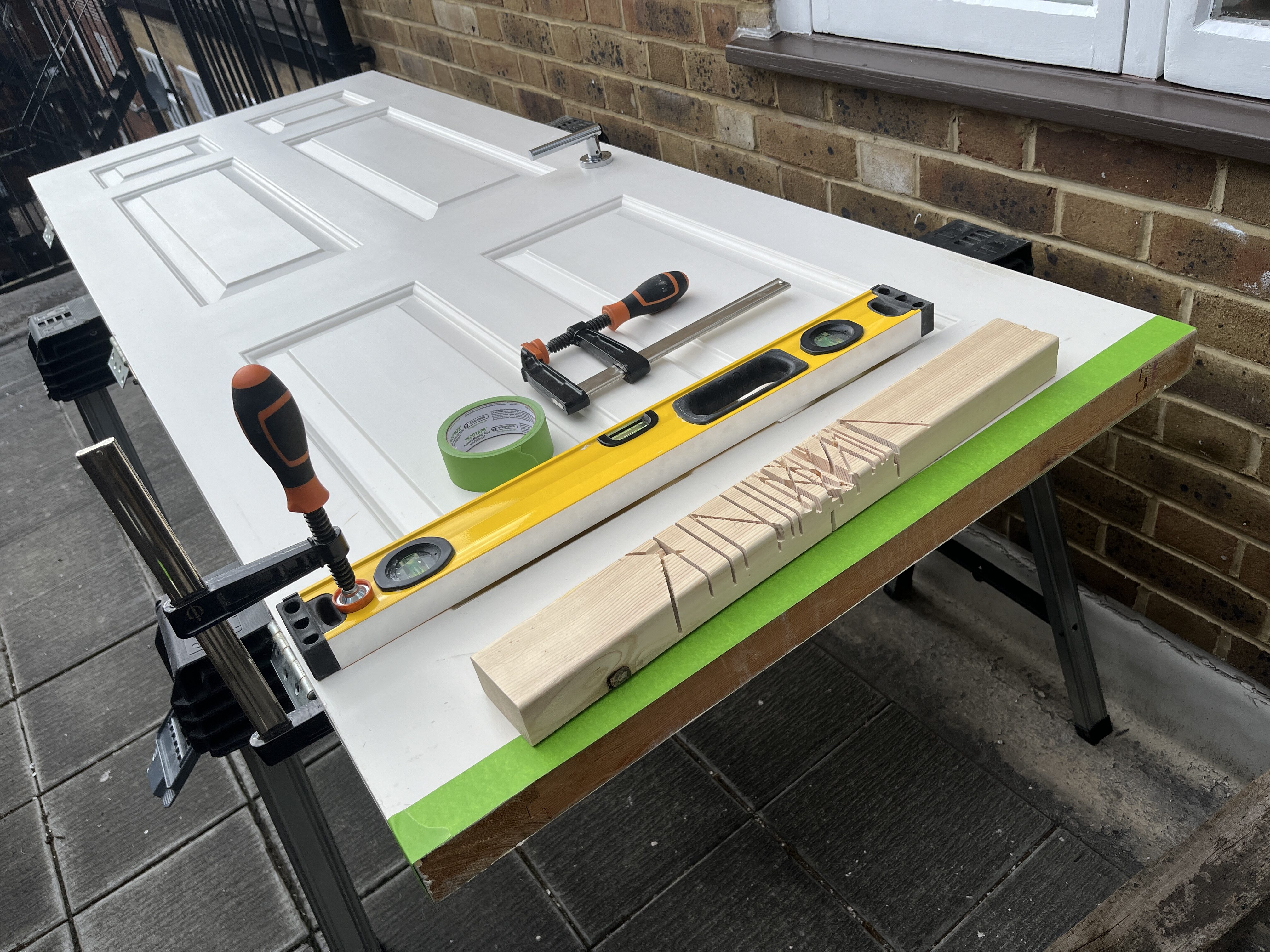I’ve learned so much from the closet expansion, and we aren’t done yet. I’ve still got the doors to build, and one final closet opening to frame and add architrave and shelving. Today, I want to share a tutorial on how to trim down a door. This can include a closet door or room door, when it will not open properly.
This was a skill I needed to pick up as part of the closet project, as we have several closet and room doors that would not open due to the addition of an area rug in the room.

You might remember that I refinished my favourite blue and purple area rug for our bedroom, to go with the lovely purple feature wall. It looks great in the room. But it interferes with the doors of the two closets as well as the door to the room.

Each time we want to open the closets or close the bedroom door, we need to flip the rug up. This is just inconvenient … and probably not great for the rug over the long-term.
The good news is, there is an easy fix if you face a similar issue. You simply need to trim down the door to cross over the rug.
Trimming the bottom of the door to skim over the rug is not very difficult and only requires a few tools. I trimmed down four closet doors and one entrance door in an afternoon. It can be a bit fiddly, as you want to be careful not to over-trim the doors. You may need to measure and cut a few times. But it is not very difficult for anyone who has used a circular saw or a jig saw before.
Let me show you how to trim down a door so you can fix any door issues you might have.
The Tools Needed to trim down a door
- A circular saw or jig saw
- A straight edge, to guide your cuts. (I used my trusty Accu-Cut; you can read about this tool in the 25 Tools in 25 Days Christmas Advent Calendar.)
- Masking tape or painter’s tape
- A pencil
- Sawhorses or other device to prop your doors on for cutting
- Doors to be trimmed down (obviously!)
The Process
Scribe the Line Where the Rug Meets the Door
The first step to trim down a door is to measure or scribe the cut you need to make. In my case, I brought the door to be trimmed close to the area rug. I then drew a pencil line along the top of the rug where it met the door. This allowed me to see exactly where the rug met the bottom of the door and was causing the blockage.

I marked the door in several places along the rug, just to be sure. Remember that your floors may not be perfectly level (ours certainly are not). This will help you see if there are any areas that may need to be cut lower or higher.
This technique for trimming down a door can also work if your door is scraping against an uneven floor. Mark where the door is scraping by scribing the cut needed. Place a pencil against the door and a scribing tool running along the floor. (Another tool you can read about in the Advent Calendar). The resulting line might not be perfectly even, but you want to capture the highest point of the floor. This is what you will want to measure for the final line.
Remove the Door
Once you’ve marked the door, where it needs to be trimmed down, it is time to remove it from the frame. This is the hardest part, in my opinion, because it can be awkward to remove a door on your own. But there is no getting around this, you cannot cut the door in situ.
If you have closet doors with hinges on the inside (as we do), you’ll want to unscrew the hinges from the door frame. I’ve tried unscrewing the hinges from the doors themselves, but they are impossible to re-install. Better to remove the hinges from the door frames.

For entrance doors, you will need to remove the pin in the hinge by using a screwdriver to tap the pin out from the bottom. We could not get the pin in the bedroom door to budge, so I ended up unscrewing the hinges from the door frame and re-installing them afterwards. This is a two-person job, and the door can be quite heavy, so find someone to help you.
Mark Your Cut Line
Once you have the measurements and have removed the door, it is time to mark your cut line. Prop the door up on some sawhorses, ensuring the door is level and secure for cutting.
Mark a line across the length of the door at the bottom, following the marks you made earlier. Make sure the cut line is visible and clear. The darker the better, as you will need to be able to see the line through the tape we will put on the door prior to cutting. (More on this in a moment.)

For the cut line, I would recommend a level line measured against the highest point of your scribed line. You could cut exactly along the scribe line if you would like, but I personally think it would be better for the bottom of the door to be straight and level to the rest of the door vs level to the floor.
But this is really a matter of preference. If a straight line would result in too much of a gap across too much of the door, you might want to make your scribe line your cut line. If you are unsure, cut your scribe line, see how it looks and then, you could go back and even it out along the highest point if you think it will look better.
There is a bit of trial and error in the process for trimming down a door, to make sure you get the right cut and do not cut too much, which cannot be undone! It may require re-hanging the door a few times, perhaps, but it is worth it to get it right.
Place Tape Over the Cut Line
Once you have your cut line marked, you want to place masking tape or painter’s tape over the line. Make sure you can still see the line through the tape, and ensure the tape extends both above and below the cut line. Wrap the tape around the door, so it covers both sides and both ends.

The tape helps protect the wood from splintering when you make the cut. It is not a perfect solution, but I found it left a fairly smooth cut that just needed some light sanding. Without the tape, you risk a jagged cut in the wood and potentially more tear-away.
Make the Cut With a Circular or Jig Saw
Once you’ve marked and taped the line, it is time to make the cut. If you are following a scribe line that may not be perfectly straight, you should use a jig saw with the blade set to align to the width of your door. Go slowly, cutting along the line. When finished, remove the tape and do a light sanding if needed.
If you are cutting a straight line, you can follow the above approach, or you can use a straight edge like the Accu-Cut with a circular saw. This is what I did for all five doors, and it worked really well. (But I forgot to get any pictures!)
Line up the Accu-Cut (or another straight edge) with the cut line, and make sure you set the right depth on the circular saw., so the blade clears the depth of the door. Make a clean cut following the straight edge, over the tape.
Pro Tip
Be conservative in your cuts. Once you trim down a door, there is no going back. Better to cut it a few times, taking a conservative approach and maybe cutting below the line a bit and testing the fit.
I was super conservative, because I did not want to over-cut and have a huge gap in the bottom of the doors. It meant that there was a lot of back and forth, taking each door out to my makeshift workshop, cutting, then re-installing and testing the fit. I got two doors right on the first cut, but three of the doors required a few cuts each, again because I was very conservative.
You also want to ensure that any two-door closet doors are even along the bottom. A different length at the point where the doors meet in the centre will look terrible, so pay close attention to this.

Re-Install the Doors
Once you are happy with the cuts, remove the tape, do a light sanding if needed, and re-hang the doors for the final time. You might need to make some slight adjustments to the hinges to ensure everything hangs straight and the doors open and close properly.

I was able to hang the closet doors on my own. Using a spare piece of thin wood to prop the door up while I screwed in the hinges, I started at the top. Once that was in, I moved to the bottom hinge, then the middle hinge. It should be fairly straight forward since the hinges go back in the same place as before.
For the bedroom door, I needed my husband’s help to carry the door and to un-install and re-install it. We propped it on a piece of thin wood to get it to the right height while I screwed the top hinges in place, then did the bottom, then the middle, with my husband holding the door in place the entire time.
Stand Back and Admire Your Work
Once you have completed the re-install, give your doors a try. Open and close them, enjoying how they smoothly glide over the area rug or the uneven floor.
Trimming down a door is such a small thing, but we have lived with doors that do not open fully, having to flip back the rug to open the closets for nearly half a year. While it was frustrating, we got a bit used to it.
How enjoyable to simply open the doors when we want to without having to move the rug. Without having to think about it.


Trimming down a door is a great example of a simple fix that can make life just a little easier with an afternoon of effort. Following my success on this one, I have one other set of closets to trim down in the office, where the fourth closet expansion is still waiting to be framed and finished. (I have been avoiding the 4th closet because the wall is so uneven that I’ve struggled with the framing. I’m building up my resilience before tackling that one!)
Do you have a door that does not open easily, where this project could help? Any questions about how to trim down a door in your specific project? Let me know in the comments.
Until next time, happy DIY-ing!









Leave a Reply